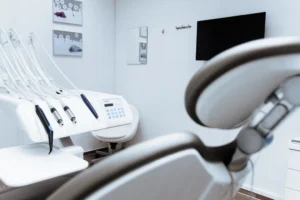USA: cost of dental practice (dental office)
How much is the cost to found a dental practice? How about the finance (banks, credit sources, etc.)
That’s another difficult question. Again, there are so many different types of practices, and so many different regions of the U.S., that it’s very difficult to guess about averages. I can tell you a little bit about my personal dental practice, which I opened in July of 2007:
Purchase fo the suite (part of the building): $757,000; 27-year loan with variable interest rate. The good news is that interest rates have been dropping steadily since we’ve opened, and that has reduced my monthly mortgage costs by over $1,500/month since last year. Naturally, when the interest rates begin to climb again, I’ll be paying more interest.
Tenant improvements (walls, ceilings, electricity, floors, doors, plumbing, bathrooms, etc.): $273,000; 27-year loan with variable interest rate.
Dental equipment, supplies, furniture, and so on: $300,000; 10-year loan with variable interest rate.
The grand total, so far, including all additional working capitol, “soft” costs, and miscellaneous fees: $1,550,000. That’s an estimate, but it should be pretty accurate.
Additional to that were costs for the architect, attorneys, accountants, construction permits, advertising, etc., for which I paid cash. That came out of my savings.
I still have three treatment rooms which are not furnished. I estimate that they will cost an additional $105,000, and I’ll probably not finish them until 2010.
Again, this is not representative of dental practices in the U.S. It’s just what I personally did last year. I know plenty of dental offices which rent a small space, have only two or three operatories, and they are up and running for under $200,000.
Here’s a final thought: I have absolutely no doubt that if I were to try to open this practice today, I would never get the loans which I got last year. Despite my good credit history and high credit rating, and despite my 17-year experience as a dentist, the current economic crisis and credit crunch is devastating to businesses looking to borrow money. I don’t know how a new dentist fresh out of the university is going to get started today? I probably could borrow less than half of what I needed if I were to open a new practice like mine today. This inability to receive credit will perhaps affect me in the near future also if I want to borrow more money for additional improvements, such as my three remaining treatment rooms. Also, if I wanted to buy an expensive piece of dental equipment right now (like a CEREC or a hard tissue laser), getting the money would be very difficult. Some dental equipment companies offer their own financing, which is good, because the banks are being very stingy with their loans right now. I’m sure the situation in Germany is similar right now.
How much is the monthly cost running a dental practice (without credits and with banking cost)
My highest monthly costs are the loans which I have to repay (mortgage, equipment, etc.).
My primary new monthsly costs, like everyone else’s, are staff salaries and materials/labs.
I don’t advertise much because of my location and the type of neighborhood in which I practice, so that is only about $1,000-1,500/month. Once in a while I launch a speical niche-marketing campaign which might cost $4,000-5,000, but that’s only a couple times per year. I’m hoping that within the next two years, I will be marketing even less. I’m trying to build by “word of mouth,” which is slow but preferable.
My receptionist and chair-side assistant receive $15-18/hour, with no additional benefits.
I do have a few “Nebenkosten” which are mandated by law (such as social security taxes, unemployment insurance, and so on), and they cost about an additional 20% per month. So, for every dollar I pay in salary, I also pay about 20 cents in additional costs for my team members. If I remember correctly, Nebenkosten in Germany are higher than the actual salary, right?
I’ll be hiring a business/practice manager next year, and I expect to pay her/him about $40,000-50,000/year to start. That seems to be the going rate around here for someone with decent experience.
I do not offer any additional benefits to my employees, except the federal holidays which are mandated by law. I offer no paid vacation days, no sick days, no medical/dental insurance, no continuing education, no bonuses, no profit-sharing plan, and no retirement plan. Nothing. I would like to offer a few benefits in the future, but that will probably take at least another two years. I just can’t afford it right now.
My monthly lab bills range from about $3,000-3,700/month. My average for 2008 so far is $3,382/month. However, the higher my lab bills are, the more prosthetic dentistry I am performing, so I’m always happy when these bills are high.
Consumables and materials cost about $1,100-1,500/month. My average so far for 2008 is $1,303/month. Again, however, the more I spend on composite, anesthetics, and impression materials each month, the more patients I am seeing, so this is an investment and not really a cost.
How is the staff paid (you told me 18 $ an hour, without additional cost)
Once again, it is impossible to make generalizations about costs, because the U.S. is such a large country with tremendous variety from region to region. You can imagine that running a multi-doctor dental practice in Manhattan or downtown San Francisco is quite different than a one-man practice in Little Rock, Arkansas or Toledo, Ohio.
Speaking only from personal experience, I would estimate that a dental assistant (clinical chairside) makes $9-20/hour. I know that in the greater Chicago area, average salaries for an experienced assistant were about $12-14/hour. Here in the Phoenix area, where good help is almost impossible to find, a decent chairside assistant makes $16-20/hour. I’m sure that in an established practice, where the staff has been loyal for 15 or 20 yeas, the pay is much higher. I also know that an 18-year-old with no training or experience can earn $8-9/hour (slightly higher than the federal minimum wage).
Dental hygienists are often paid on commission (i.e., a percentage of their production). I have known hygienists who were very productive, and were very good at getting patients to accept treatments above and beyond their regular prophylaxis (up-selling), such as fluoride treatments, tooth whitening, desensitizing applications, and so on, who made $80/hour. Pretty good for only two years of college! Hygienists who are being paid a straight salary usually fall into the $30-45/hour range, again depending on their location and experience.
A good practice manager (someone who runs the actual business) generally earns somewhere in the neighborhood of $22-28/hour, but this can go much higher as well, if the practice is very successful.
There is no legal requirement to offer benefits of any kind to dental staff. Most practices do offer some benefits, in order to attract and keep quality personnel, but that is optional. However, smaller practices, or start-ups often offer no benefits at all.
If benefits are offered, they can be quite diverse, including such things as health insurance, free dental work, paid time off, paid sick days, profit sharing, or an employee retirement plan. Sometimes they are of less value, such as free uniforms, a gym membership, free continuing education classes, etc.
In either case, they are optional.
How is the staff educated (skilled, unskilled, dental hygienist – how educated -, etc.)
Dentists, obviously, must have a university degree and a state license.
Dental hygienists must also have a university/college (no difference) degree and a state license. The dental hygiene program itself is two years, but with the prerequisites and additional courses/work often required, it can take three or four years to complete. State licensure, just like for dentists, is broken down into regions, with some reciprocity between states under certain conditions.
Dental assistants have no legal requirements. There are accredited programs available, which run for just a few months, but it is not mandatory that a dentist hire a graduate of such a program. In my experience, the majority of dental clinical assistants have been trained “on the job” by the dentist and existing team members. However, if a dental assistant is going to take radiographs, for example, she must take a state-approved course and pass the accompanying examination. Similarly, if she is going to perform certain intra-oral procedures (like coronal polishing or placing orthodontic brackets/bands), some states require coursework and testing.
How is the layoff of staff? Are there regulations?
Again, legal requirements and conditions of employment vary from state to state. Arizona, for example, is referred to as an “at will” state. This means that employment of any kind is always at will: at the will of the employer, and at the will of the employee. This means that at any time, for any reason, or for no reason at all, any employee can quit any job at any time, without notice, and any employer can terminate any employee, at any time, with or without cause or notice. Pretty harsh, but that’s the way the folks around here like it.
The only exceptions to this rule of firing employees are the legally protected “minorities.” Therefore, it is not legal to dismiss an employee because of gender, race, age, greed, religion, physical disability, and so on.
How much paid holidays are there? How much is the minimal wage? How much are vacations totally? Are there regulations by law?
The Federal Minimum Wage is currently $6.55/hour (since July 24, 2008). The minimum wage in Arizona is slightly higher than the federal rate, at $6.90/hour (since January 1, 2008). Arizona raises its minimum wage every year on January 1, based on inflation and the cost of living increase. The federal rate doesn’t get adjusted very often.
As far as vacations are concerned, there is no legal requirement to pay them to employees in any way. Benefits like these are optional, but fairly common, in order to build a dedicated and loyal team.
Federal holidays must be paid at the employee’s regular rate. Currently, there are ten federal holidays (see the internet for a complete list).
Are there regulations about pricing (compared with Europe with “Gebührenordnung”)?
Fees for dental procedures are dictated completely by the free market and the type of practice in which you work.
On the one end, there are very many practices which have entered into private contracts with dental benefit companies. The insurance company agrees to promote the practice—on their website, for example—and in exchange for them sending you patients (theoretically), you agree to provide treatment at a reduced cost. This reduction can be very little, such as a 10% discount, or extremely large, as in over a 50% reduction of your normal fees.
I know practices that have over 50 such contracts with private dental insurance companies. Obviously, if you practice in an area where dental insurance is not common, or where most people have “traditional” non-reduced fee insurance, you would never enter into such contracts. But, there are large areas of the country, where nearly 100% of the population as such “discounted” dental insurance, and if you decide not to accept it at your practice, you can significantly limit the number of potential patients who might chose you, even if they wanted to.
On the other far end of the spectrum are practices that are not “in network” with any insurance companies. They still may “accept” a patient’s insurance, but they will charge their normal fees, and the patient will be responsible for the difference between the bill and the amount paid by insurance.
At the very high end are practices that don’t deal with insurance at all. The patient pays in full and then submits his own claim to his own insurance. The insurance benefit is then paid directly to the patient. Obviously, all dentists would love to work in a practice like this, but they are rare, and reserved for very well-known dentists (“dentist to the stars” for example) and are generally found in very exclusive neighborhoods. These types of practices tend to be quite high-priced, as you can imagine.
How about the insurances? (you told me, you would make personal contracts with the insurances)
As stated above, fee structure and amount is completely at the discretion of the dentist. If I think my patients will pay $1,500 for a crown, then that’s what I charge. If I think they’ll only pay $800, then that’s what I charge. If all the dentists in my area are charging $2,000-2,200, then I’ll probably be in the same range. Unfortunately, if all the dentists in my area are charging only $600-700, then I’ll probably have to follow suite as well.
Obviously, practicing in an area with few competing dentists has a huge advantage when it comes to setting fees. Also, practicing in an economically or socially depressed area is not a good idea, if you’d like to have a decent profit margin on your dental procedures.
I personally am “in network” only with Delta Dental of Arizona. I chose to do this because they are the largest insurer in Arizona, covering about 60% of the labor force. Additionally, they allow decent fees (similar to what I would charge anyway) on most procedures. Also, because I accept Delta exclusively (not a member of any other dental plans), they give me a higher reimbursement rate than other dentists who accept multiple insurances.
Because a large portion of my production comes from procedures which are not covered by dental insurance anyway—such as implants, veneers, whitening, adult orthodontics, etc.—I don’t care what kind of insurance coverage most of my patients have, since they have to cover 100% of these costs anyway. It’s similar in Germany if you offer things which are not covered by insurance—then it really doesn’t matter what the GOZ states.
Do you treat patients, paid by Medicare or Medicaid? Are you forced to treat this patients or can you refuse the treatment?
Medicare (retired persons over age 65) does not cover any dental expenses. Patients receiving Medicare benefits for their medical care must cover their dental expenses completely “out of pocket.” Medicare is a Health Insurance Program for people 65 years of age and older, some disabled people under 65 years of age, and people with End-Stage Renal Disease (permanent kidney failure treated with dialysis or a transplant).
Medicaid covers only very basic dental care, such as extractions, some endodontics, and (amalgam) restorations. Medicaid is a joint and voluntary program between the federal government and the states, with the mission to provide health insurance coverage to the nation’s poor, disabled and the impoverished elderly people.
Here’s an outline of what is covered by Medicaid, typically:
Traditional Medicaid: aged, blind, disabled, non-pregnant adults, twenty-one years of age and older.
• X-rays
• Fillings
• Simple tooth extractions
• Root canal treatment for permanent teeth (excluding second and third molars)
Traditional Medicaid: children, birth through twenty years of age, and pregnant women of any age.
• Two dental examinations a year with x-rays and cleaning
• Topical fluoride applications and sealants
• Fillings
• Root canal treatment (excludes second and third molars for pregnant women)
• Orthodontia in cases of severe malocclusion (prior approval required)
• General anesthesia (prior approval required)
Non-Traditional Medicaid: non-pregnant adults nineteen through sixty-four years of age
Not covered.
Taking patients with these types of plans is completely voluntary. In fact, it can be quite difficult to find a dentist who will accept Medicaid. There are only a few here and there…of course, they see dozens of patients a day and probably have pretty good production. The time they can take with each patient and the quality of the dentistry they can offer, however, are (it seems to me) significantly diminished.
How much, do you calculate, of your patient have got an insurance and how percentage are totally uninsured and do pay out of pocket?
In Illinois, nearly 100% of my patients had dental insurance. I practiced in a nice little suburban town, with mainly working-class families, who had insurance through their employers. However, they all had traditional “indemnity” insurance, which means that they could see any dentist they wanted, the dentist could charge any fee he wanted, and the insurance would reimburse a percentage of the cost, while the patient would pay the difference.
Now, I practice in a mixed community, with working-class families, but also thousands of retired people. So, the demographics are quite different.
In Arizona, there is very little traditional “indemnity” insurance. In fact, since I opened my practice in July of 2007, I have had only one patient whose dental insurance was not restrictive and limiting in his choices.
All other insured patients have some sort of restrictive insurance. The most common type of this insurance is known as “PPO = Preferred Provider Organization.” This means that if a patient chooses a dentist who is a “preferred provider” for their insurance (i.e., someone who has agreed to accept these patients at a reduced cost), that patient will receive greater benefits. So, if they chose from a list of providers and go there for their dental care, they will pay less money, and their insurance will provide greater reimbursement. These patients still have the option of going to someone who is not on the insurance list, but then they receive fewer benefits and have to pay more out of pocket. I personally have many, many patients who chose to see me despite having to pay more, because they value the service, convenience, and care I provide for them. They are happy to pay a little extra for the better experience.
Arizona also has a lot of people who have what is known as a “DMO = Dental Maintenance Organization” (often also called an “HMO = Health Maintenance Organization ) insurance plan. This is the least expensive type of plan, it is very restrictive, but for most patients it is better than nothing. DMO patients must chose from an approved list of providers, or they get no benefit at all. They have zero choice: if they deviate from the list, they get zero benefit. In fact, in many cases, the DMO actually assigns these patients to a dentist, and they have no choice at all in whom they see. I have met several patients who have such a cheap and restrictive DMO, that their nearest dentist who will accept their insurance plan is down in Tucson, over an hour away.
Then there are “capitation” plans. These are also terribly restrictive and offer no real benefit as far as quality of care. These plans pay a dentist a certain amount of money per patient per month. That means, if you are a provider under such a capitation plan, for example, and you have accepted 100 patients into your practice, the plan will pay you (for example) $10/month for each patient, whether you see them or not. So, the insurance pays you $10,000/month, every month, and you provide all the necessary dental care to these patients for that amount. So, obviously, the fewer of these patients you actually see and treat, the more money you make. These dentists usually make it very difficult and inconvenient for these patients to be seen, and they offer very little quality care and time. Every patient you see, every procedure you perform, every minute you spend, you lose money under such an arrangement. I think they are immoral and disgusting, and they should be outlawed. On the other hand, if you are a poor person with a toothache, you’d probably be happy to have the opportunity to see any dentist, at any time, under any conditions…
In any case, I personally accept Delta Dental of Arizona as a preferred provider, and all others who would like to see me can, as long as they understand that they will have to pay more than if they were to chose from an approved list.
My personal patient breakdown is as follows: 69.8% have dental insurance, the rest pay cash.
How is the cash flow, I mean: do patients pay in advance, in order to the step of treatment or after finishing treatment? Do patients pay cash or with credit card or by checking or account transfer?
Insurance patients pay their expected portion at the time of service, then we bill their insurance for the rest.
Cash patients pay the entire portion at the time of service.
For larger cases, we offer a 10% bookkeeping reduction if the entire sum is paid in advance; this is true for all patients.
For cases up to $2,000, I will (sometimes) extend payment options for three months, interest-free.
If a patient needs longer than that, or if the total is over $2,000, I also offer third-party (outside) financing through Care-Credit. This is a credit company specifically for dental procedures. The application takes about five minutes over the phone, and patients will be told immediately how much of a loan they can have. Care-Credit offers several different plans to dentists. The one I usually offer to my patients is equal payments up to 12 months without interest to the patient. If the patient is approved by Care-Credit, I get the money deposited into my account the next day, and we can start treatment. Care-Credit charges me a fee for the service (basically the interest on the patient’s loan), but I get my money before we even start, which is nice. The patient then makes payments directly to Care-Credit (just like any other credit card). I paid the interest up-front, so the patient simply pays off the cost of the dental work he’s having done. However, if the patient misses a payment or is late, he will be hit with fees, penalties, and interest (but that’s not my problem). I don’t use Care-Credit very often, since I practice in a decent area where people can afford to pay their portions, but it’s nice to have it in reserve.
I accept cash, check, Visa, MasterCard, Discover, and American Express. Most patients use a credit card of some sort. I rarely get cash or a check.
How much is total income in relationship to cost? (e.g.: in Germany there are average cost of about 50 %)
That’s a difficult question. Excellent practices have an overhead around 55%. Very efficient practices run between 55-65%. But most practices have expenses which are around 70-80%.
It just depends on where you are and how you practice. If you have a high-end fee-for-service (no insurance patients) practice with only one assistant and one hygienist, and your wife is running the office and answering phones, and you do large cosmetic cases all day long, then you can probably keep more than 50% of your total production, and you can still afford to pay your staff very well and use excellent materials and labs. If, on the other hand, you are in the inner-city, accepting all kinds of discount and DMO plans, and you see 40 patients a day doing simple fillings and offering emergency care, and have a staff of seven, your overhead is going to kill you. Another nightmare scenario is a modern, state-of-the art practice, which uses very expensive materials and equipment, uses high-end laboratories, but accepts mainly PPO and HMO patients. Their expenses can be ridiculous.
Another big factor is whether you own or rent, how much land (parking, trees, grass, etc.) you have, if it’s a stand-alone office or in an office building, and so on. Mortgages and property taxes can be very high these days, especially on businesses. Arizona property taxes are pretty low, but New York dentists with their own stand-alone practices can easily pay $50-75,000 each year in taxes alone.
Malpractice insurance can also be huge, especially if you area a specialist. Oral surgeons, especially those who perform major (cancer, trauma, etc.) reconstructions, cosmetic facial surgery, and complex implant surgery, pay thousands of dollars each month in liability insurance.
Marketing expenses can also consume huge amounts of cash. I know several dentists who spend $12-14,000 each month simply on external marketing. I also know some practices which don’t advertise at all, so zero dollars per month on marketing. Many, however, spend 5-10% of their production on advertising. Because of my area and my reputation, I now do very little external marketing. About 80% of my new patients are referred by existing patients, so my monthly advertising budget is only about $1,500.
Dentists in the U.S. also have pretty high continuing education demands, which can run into some serious money. I would estimate (from personal experience), that the average dentist in the U.S. spends around $10,000 per year on continuing education courses and attending meetings. That has to be included in your monthly expenses too, as you know.






